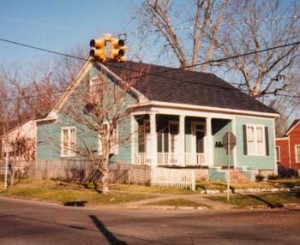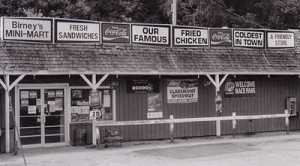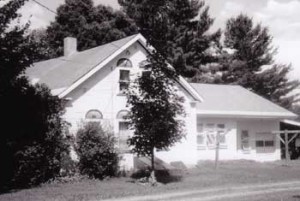Beckoned by landscapes beyond the archive
As a lover of archives and a historian of the nineteenth century, I cherish my time inside the vault, thriving on chilled air and pitiable handwriting. I was therefore surprised to find that following every lead in a collection of family correspondence took me out to the open road, tracking down an intersection in a New England town, a house in a Gulf South city, even a particular expanse of sand on a Caribbean island.
My recently published book, The Sea Captain’s Wife: A True Story of Love, Race, and War in the Nineteenth Century (2006), began with a trip to the Special Collections Library at Duke University. There I found a collection of five hundred or so letters written by the members of a white, working-class family from New England. Among the letters, those of one family member particularly captured my attention. Eunice Richardson Stone Connolly married a fellow New Englander, but unlike Connolly’s brothers who fought for the Union, her husband fought and died for the Confederacy. Then, after the war, Eunice married a man of color, a well-to-do British West Indian sea captain, who brought her to his home in the Cayman Islands where she lived for the rest of her life.
To write Eunice’s story—which is also a story about the mercurial nature and abiding power of racial classification—I followed her: from New Hampshire, where she married her first husband and worked in the cotton mills; down to Mobile, Alabama, where she moved in 1860, hoping for a better life in a booming southern city; back to New England, where she returned in the middle of the war, after her Yankee husband had enlisted in the Confederate Army; and across the Caribbean Sea to Grand Cayman Island.
In an effort to plot the transience of Eunice’s New England family—they were separated by marriage and remarriage, repeated searches for wage labor, and the Civil War—I compiled a master list of places where each relative had lived, then matched street names and the occasional house number with city directories, census records, and vintage village maps. I hadn’t at first intended to take my research beyond the literal vault, but when I began to visit local archives, I found it irresistible to scout out the places described in the letters. Each time I set out, I imagined that finding a road or a building would bring me closer to past lives than a mere letter ever could. At the very least, I hoped, my excursions would enhance my book’s descriptive narrative.
In Manchester, New Hampshire, where Eunice’s story began, the places of her life turned out to be the most elusive. I walked a long way on a gray day, up and down Mast Road in Piscataquog Village and across the bridge in West Manchester where, according to a city directory, Eunice, her husband William Stone, and their young son had lived in the early 1850s. Without a house number or an intersection, though, there was nothing to point me toward Eunice’s daily whereabouts. (For Eunice’s mother, I had a rare actual address in downtown Manchester, but this too proved elusive, since all traces of 18 Hanover Street had been swallowed by the Queen-Anne style buildings erected in the late nineteenth century.)
In Mobile, Alabama, where Eunice lived when the war broke out, I made my way down Government Street, up Broad, and along Old Shell. “When I left, Ellen was living on the corner of Shell Road & Hallett Street,” Eunice later wrote, referring to the sister who had preceded her to Mobile (and who became an ardent Confederate). The Stones had boarded with Ellen’s family, and for the first time I found a house (fig. 1). A local guidebook revealed that the bright blue building on the northwest corner of Shell and Hallett had been a sashmaker’s cottage in the nineteenth century, and indeed Eunice’s husband and brother-in-law were both carpenters who fashioned sashes for windows and door frames.
“Excuse me, sir, do you live here?” I asked a man entering the house. Through the distinct aroma of morning drink, he told me that the house, an old one indeed, was now broken up into apartments. Eunice crossed these very corners, I told myself, but the hanging traffic signal, telephone poles, and stop sign seemed to make her ghost shy. Later that day, a file at the Mobile Historic Development Commission revealed that a fire had broken out several years earlier, and before that a car had driven into the house, prompting reconstruction. Maybe so much change had driven away the spirits of the past.
During the war, Eunice returned to the North, to Claremont, New Hampshire, where she struggled to support herself and her two children as a washerwoman. On a visit there, I used a nineteenth-century map and a Chamber of Commerce tourist pamphlet to plot the crossroads at which her rented tenement stood. “Take the coach and tell them when you get to the village that you want to go to Mrs. Stones on Washington street next house to Leonard Fishers,” Eunice had directed her mother, traveling from Massachusetts in 1864. The old map clearly marked Fisher’s house near the intersection of Washington and Winter Streets, but when I drove by (then turned around and drove by again), I saw that whatever surroundings Eunice knew had been obliterated by a low-rise apartment complex and a rickety commercial strip (“Birney’s Mini-Mart,” “Our Famous Fried Chicken,” “Claremont Speedway”). For good measure, I followed Eunice’s descriptions to where her in-laws had lived farther down Washington Street; here the approximate location yielded quickly to left-turn lanes, Dunkin’ Donuts, McDonald’s, and Wal-Mart. No welcome for nineteenth-century ghosts there either (fig. 2).
Suffering from the shock of widowhood after the Civil War, Eunice convalesced in her mother’s subsequent home on Mammoth Road in Dracut, Massachusetts, just across the bridge from Lowell. This dwelling was also the likely venue of Eunice’s 1869 wedding to the black sea captain, Smiley Connolly. At the Center for Lowell History, I examined city directories and census records, counting back from where Mammoth Road meets the New Hampshire border—that’s where the census taker for Middlesex County began his rounds. Then a local genealogist with a pick-up truck drove me to the house.
About a half-mile beyond the intersection of Mammoth and Lakeview (Dunkin’ Donuts graced a corner; we had already passed a McDonald’s) stood a building worthy of transporting a historian back in time: a white-painted colonial with eight neatly black-shuttered windows and a picket fence on either side. As we walked around the old graveyard and down the hill, I felt a vague sense of proximity to Eunice, but these were the early days of my research, and it didn’t occur to me to knock on the door of her former home.
Another part of my Massachusetts research, though, allowed a closer communion with the landscape of the past. An archivist at the Center for Lowell History assisted me as I traced Eunice’s ambitious brother, Henry Richardson, from one city directory to the next (Henry never again spoke to Eunice after she married across the color line). In the 1890s, Henry had served as agent of the Appleton Mills, the highest local executive, and I found him listed as living on Highland Street in Lowell. “I know the people who live in that house,” the archivist told me; they were good friends, in fact, and she promptly arranged a visit.
The Italianate-style, yellow clapboard, dating from the 1860s, bore a historic plaque naming it as the home of the Appleton Mills agent. The interior had been remodeled over time, but the owners served coffee and scones in the dining room where the floor, fireplace, bay window, light fixtures, door, and wood trim were all original. Eunice had never entered these rooms (she died in the Caribbean in 1877), but Henry had appointed himself keeper of the family correspondence, and no doubt the bundles of letters now housed at Duke once rested somewhere inside. Here, as in Dracut, I sensed the spark of time travel, but even the most vaporous spirits seemed unable to slip between the apertures of the past and this particular May evening.
In tiny Morristown, Vermont, where Eunice went to live in 1866 after her mother could no longer support her, I came the closest to meeting my protagonist. The president of the Morristown Historical Society (a ninth-generation Vermonter) helped me locate the house where Eunice had boarded with Melissa and Moses Rankin, her deceased husband’s sister and brother-in-law (fig. 3)—again we used a nineteenth-century map that included the names of each dwelling’s occupants. That July day, I stood across the road and looked; the next day, when I returned on my own, I knocked on the door.
Here’s how I render the scene in The Sea Captain’s Wife : “When there was no answer at the front, I walked around to the side (Saturday, a car in the driveway, laundry on the clothesline—someone should have been inside). A woman emerged. ‘I’m writing a book about a person who lived in this house in 1866,’ I told her. The woman had never heard the name Rankin, but I sat at her kitchen table while she retrieved the papers from her late husband’s search through property records, and in his notes we found the name. The interior of the house had been greatly altered in the intervening 137 years, the woman explained—the center hallway, stairwell, and chimney moved; small rooms opened up—but she pointed out original beams and walls that had known Eunice’s presence. She rummaged through a drawer to find her own snapshots of the house in wintertime (how it looked when Eunice lived there, we imagined) and generously gave them to me. The unbroken quilt of snow in the photographs lent a timeless quality to the surroundings, making it easier to envision Eunice’s presence at the front door.”
But it was actually much harder than I made it sound. For one thing, I was more nervous about intruding than those breezy sentences convey. For another, it proved more difficult to imagine Eunice’s presence than I would have liked. “I have a fire every night and morning,” she wrote from Morristown, describing how she would “lay down with a hot free stone and the curtains put down.” But the chimney had been moved and the rooms reconfigured; I knew Eunice had been there, but I couldn’t bring that sentence quite as alive as I’d hoped.
On Grand Cayman, in the village of East End, I also found a relatively unaltered landscape; once a settlement of former slaves, East End has been slower than the rest of the island to transform into a destination for tourists and wealthy expats. In her letters back to New England in the 1870s, Eunice described the house that Captain Connolly was building for her, noting how the many bedrooms would open up, one next door to the other. When I asked a Connolly descendant where Eunice and Smiley had lived, he exclaimed, “I can show you!” The house, which had been inherited by one of Smiley’s sons from his first marriage, was destroyed in a twentieth-century hurricane, but this seventy-eight-year-old man recalled the mahogany foundations and took me to the land, where a newer house now stood.
Another descendant also recalled the house, including the wooden gallery that ran all around the top part of the second story—but she remembered the dwelling as standing on a plot of land about a mile farther west (and inherited by a different son, her grandfather). She, in turn, took me to that piece of land, where a bar called the Pirate’s Cove now stood. There had been a loft upstairs, she recalled, and a porch facing the sea.
The caretaker climbed a ladder and shook two coconuts from a palm tree; then one of his workers cut them open so we could drink the milk. Assuming that Eunice had lived on this expanse of beach, I tentatively envisioned her—of course she sipped milk from coconuts in summer too—until our host informed us that the palm trees were only recently planted. They hadn’t been there at all in Eunice’s day (fig. 4).
Maybe the writer Geoff Dyer, posing as a struggling biographer of D. H. Lawrence, put it best: “You try saying a mantra to yourself,” Dyer writes. “‘D. H. Lawrence lived here.’ You say, ‘I am standing in the place he stood, seeing the things he saw . . . ,’ but nothing changes, everything remains exactly the same.” Or listen to literature professor Saidiya Hartman, walking through a castle in Ghana that once imprisoned enslaved Africans: “I closed my eyes and strained to hear the groans and cries that once echoed in the dungeon, but the space was mute.”
I could have gone back to knock on the door in Mobile or Dracut or to see the Vermont house in wintertime. But during my travels, I learned that a place in the present is less likely to conjure the past than it is to confirm our distance from the past. A place by itself, of course, isn’t a time machine, since the passage of time can so thoroughly alter a landscape. But even buildings little marked by time’s passage can remain unyielding, surrounded as they are by evidence of change—the fast-food chain across the street, the interstate highway that got you there.
As a historian of the Civil War era, I’ve walked through the meadows and woods of preserved battlefields only to feel the tug of the time machine interrupted by the rows of monuments; though intended as testaments to the past, those imposing markers serve also to erase a landscape’s past. (I remember Professor John Murrin of Princeton University remarking that he liked to ask tour guides how the troops in the American Revolution shot at each other with all those monuments in the way.)
In The Sea Captain’s Wife, I open each chapter with a brief act of historical imagination, describing Eunice’s surroundings when she lived in northern New England, the Gulf South, and the British Caribbean. “To find a view that she took in,” I write in the chapter that takes place in Cayman, “look past East End’s convenience store, gas station, and lighthouse (built only in the twentieth century), toward any unobstructed vista of the crystalline jade and turquoise waters, next to a band of fine white sand or the rugged ironshore, that jagged, blackened rock that rings the Cayman coastline.” But in the process of writing such descriptions, I came to see that this kind of exercise works better for the reader than for the historian. Even in Vermont, where I explored the house in which Eunice had sipped whiskey by a fireplace in 1866—even there, I found the best I could hope for was a subtle combination of the evocative and the elusive.
Other historians may be more adept at time travel than I. For me, those well-preserved letters—faded ink on creased paper—ultimately brought me closer to Eunice than the places where she had lived and walked ever could. In the end, the streets and the street corners, the houses and the sand, offered only the least I had hoped for: a way to write a more richly descriptive historical narrative, one that permits readers—in an armchair, on the subway, in a waiting room—what the literal landscape did not permit me: a journey back in time. The historian’s imagination will always be interrupted by gaps in the sources and by the ever-eroding landscape. Our readers, on the other hand, unburdened by literal encounters with places and change, possess the luxury of imagination unmoored.
Further Reading:
For writers grappling with an unyielding landscape, see Geoff Dyer, Out of Sheer Rage: Struggling with D. H. Lawrence (New York, 1997) and Saidiya Hartman, Lose Your Mother: A Journey Along the Atlantic Slave Route (New York, 2007).
Various historians have invoked the land as a historical document. In Tumult and Silence at Second Creek: An Inquiry into a Civil War Slave Conspiracy (Baton Rouge, 1993), Winthrop D. Jordan imagines the sounds of Mississippi in 1861, including thudding axes, hooting owls, and wind in a chimney. In The Unredeemed Captive: A Family Story from Early America (New York, 1994), John Demos describes the way his protagonist walked on snow, through (as revealed in a footnote) his own experience of “wintertime travel in the New England woodlands.” For The Murder of Helen Jewett: The Life and Death of a Prostitute in Nineteenth-Century New York (New York, 1998), Patricia Cline Cohen strolled the streets of lower Manhattan where her protagonist lived and died. For “The Provincial Archive as a Place of Memory,” History Workshop Journal 58 (Autumn 2004): 149-66, Rebecca J. Scott walked into the Cuban countryside in search of clues to the rebels she was tracing. In A Murder in Virginia: Southern Justice on Trial (New York, 2003), Suzanne Lebsock lay down on the ground in a farmyard so a companion could tell if a dead body was visible from a certain spot. In The Gettysburg Gospel: The Lincoln Speech That Nobody Knows (New York, 2006), Gabor Borritt, who has lived on a Gettysburg farm for twenty-five years, lends the authenticity of place to his study of Abraham Lincoln. In Steel Drivin’ Man: John Henry, the Untold Story of an American Legend (New York, 2006), Scott Reynolds Nelson offers a meditation on present-day pine trees in order to trace the history of a particular part of Virginia. For The Lost: A Search for Six of Six Million (New York, 2006), Daniel Mendelsohn crawled into an underground hole in the Ukraine to call up the experience of relatives who died in the Holocaust.
This article originally appeared in issue 7.4 (July, 2007).
Martha Hodes is a professor of history at New York University. The Sea Captain’s Wife: A True Story of Love, Race, and War in the Nineteenth Century is an alternate selection for Book-of-the-Month Club, Literary Guild, and Quality Paperback Book Club; it was a finalist for the Lincoln Prize and was named one of the best books of 2006 by Library Journal . You can find out more at The Sea Captain’s Wife. Hodes is also the author of White Women, Black Men: Illicit Sex in the Nineteenth-Century South and the editor of Sex, Love, Race: Crossing Boundaries in North American History.























